#Celtic archeology
Text
greatest bit he’s done yet
#miniminuteman#milo rossi#thank you my favorite archeology white boy!!!!!!#ma babey#massachusetts#i love him so much#and also massachusetts#and the celtics#💚💚💚
1K notes
·
View notes
Text
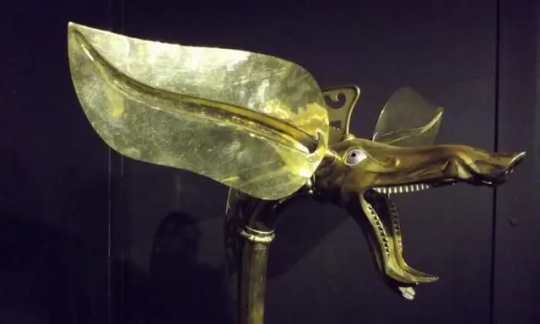

The 'Carnyx' Nightmare of the Roman Soldiers
The Carnyx was a brass musical instrument used as a psychological weapon of war by the ancient Celts between 300 BC and 200AD in western and central Europe and beyond.
The carnyx was once widespread throughout much of Europe, although only a dozen or so fragments are known to us.
It was carried by bands of Celtic mercenaries; it was present at the attack on the Greek sanctuary at Delphi in 279 BC; it defied Julius Caesar in Gaul; and it faced Claudius when he invaded Britain. They are even shown on a Buddhist sculpture in India, proof of the far-flung connections of the Iron Age world.
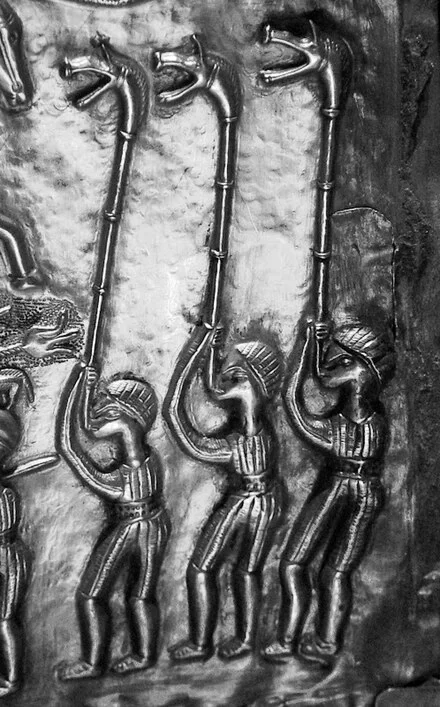
However, they were not only used by the Celts; they were also used by the Dacians in modern Romania. The term “Celtic” is a complicated one. The concept of a pan-European Celtic culture is a myth; rather, aspects of art and technology were shared across vast distances by diverse cultures. The carnyx was one example of this.
A 12-foot-long, thin bronze tube with right-angle bends on both ends made up the carnyx. The lower end ended in a mouthpiece, and the upper end flared out into a bell that was usually decorated to look like a wild boar’s had. Historians believe it had a tongue that flapped up and down, increasing the noise made by the instrument. The carnyx was played upright so that the boar’s head bell protruded well above the warriors’ heads. Its primary goal was to create more noise and confusion on the battlefield.
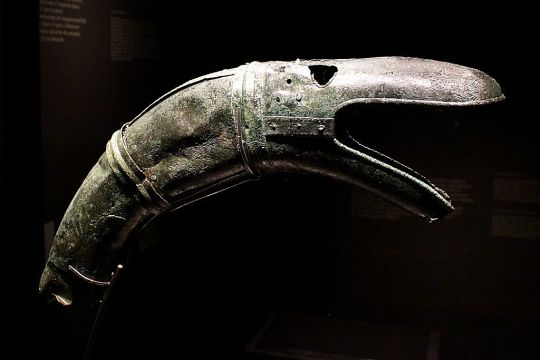
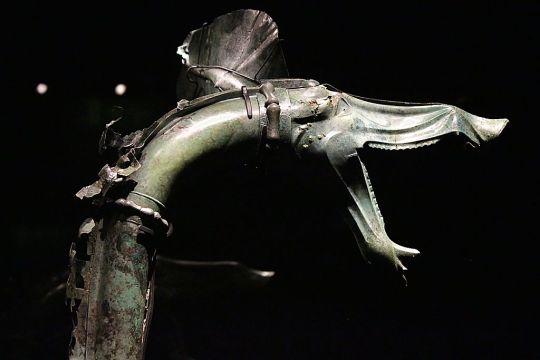

The Greek historian Polybius (206-126BC) was so impressed by the clamor of the Gallic army and the sound of the carnyx, he observed that “there were countless trumpeters and horn blowers and since the whole army was shouting its war cries at the same time there was such a confused sound that the noise seemed to come not only from the trumpeters and the soldiers but also from the countryside which was joining in the echo”.
And the Roman historian Diodorus Siculus wrote, “Their trumpets are also of a peculiar and barbaric kind which produce a harsh, reverberating sound suitable to the confusion of battle.”
Archaeologists discovered a hoard of ritually destroyed weapons in 2004, including a dozen swords, scabbards, spearheads, a shield, bronze helmets, an iron helmet shaped like a swan, a cauldron, animal remains, and seven carnyces. Before the Tintignac discovery, the remains of only five actual carnyces had been found.
The finest was unearthed in Deskford, Scotland in 1816. The Deskford carnyx only has the boar’s head bell and is missing the mane, tongue, and tubing. Images of Carnyx players have been found as well. A Roman denarius, dating from 48 BC bears a representation of a Carnyx. Three carnyx players are featured prominently on the Gundestrup Cauldron, which was found in a Danish peat bog.
One of the seven found at Tintignac, on the other hand, was almost entirely complete. The Tintignac Carnyx was broken into 40 pieces. When puzzled back together, it was found to be just an inch short of six feet long with a single missing section of the tube. The bell was a boar’s head with protruding tusks and large pointed ears. Once restored, the Tintignac Carnyx proved to be the first virtually complete carnyx ever found.
By Leman Altuntaş.
Music video by John Kenny.
#The Carnyx#The 'Carnyx' Nightmare of the Roman Soldiers#Iron Age war trumpet#ancient artifacts#archeology#archeolgst#history#history news#ancient culture#ancient civilizations#celtic mythology#celtic history#roman history#roman empire#roman legion
3K notes
·
View notes
Text

Bibracte
#bibracte#musee#archeologie#enceinte#porte fortifiee#reconstitution#museum#archeology#gallo romain#antiquite#burgundy#celtes#eduens#gaule#antiquity#epoque gallo-romaine#celtic#bourgogne#france#fortification#mur#roman empire#celte
47 notes
·
View notes
Text
Archaeological research being done on Ulster Royal Site in Ireland
12 notes
·
View notes
Text



Source: The Dictionary of Celtic Myth and Legend by Miranda J. Green (1992)
3 notes
·
View notes
Photo
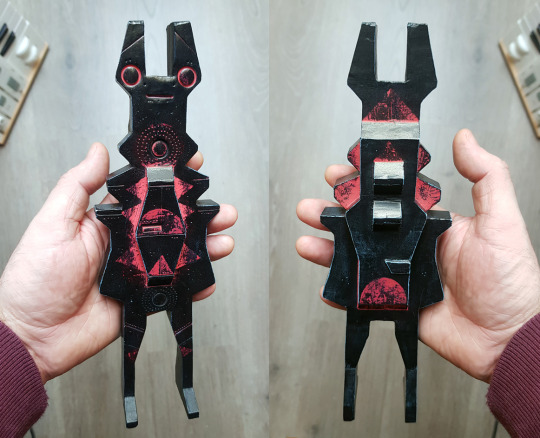

some new kozmik friendzzzz
#folk#folkart#ceramic#pictish#lego#ceramiclego#lowbrow#aberdeenshire#scotland#scottishsculpture#ssw#kilnfired#pictishtreasure#deity#kozmiklordz#kozmik archeology#egyptian#celtic#process#picts#fineart
52 notes
·
View notes
Text
wearing a long linen overtunic in dark saffron, buttoned high at the neck, with the sleeves unbuttoned and rolled up so that I can strip meat and chop vegetables to make chicken soup. listening to scottish folktales. its midnight. really feeling whatever this vibe is
#medieval aesthetic#cottagecore/cottage witch but make it OLD old#medieval studies#archeology major#celtic#scottish folklore#gaelic folklore#irish folklore#beowulf#anglo-saxon
2 notes
·
View notes
Text
Pre-Roman Timeline of Europe




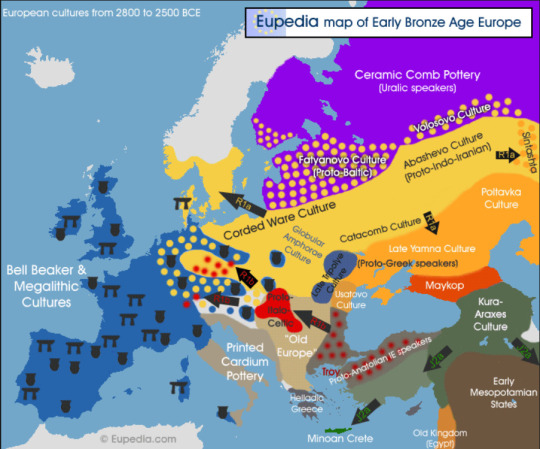
Neolithic Cultures: 6000 BC - 3000 BC
Bronze Age Influence: 4000 BC (pre-Yamnaya) - 2000 BC
Megalithic Era: 3000 BC (Yamnaya Expansion)
Corded Ware Culture: 3000 BC - 2500 BC
Bell Beaker Culture: 2800 BC - 2200 BC
Unetice Culture: 2200 BC - 1600 BC
Tumulus Culture: 1600 BC - 1300 BC
Unfiled Cultures: 1300 BC (Bonze Age Collapse & Rise of Celtic Culture) - 750 BC
Hallstatt Culture: 1200 BC - 500 BC (Rome founded in 753 BC)
La Tene Culture: (450 BC - 43 AD)
Roman Era: (50 BC - 476 AD)
Dates are not approximate
#indo european#celtic#celts#urnfield culture#anthropology#history#archeology#europe#pottery#time line#rome
2 notes
·
View notes
Text
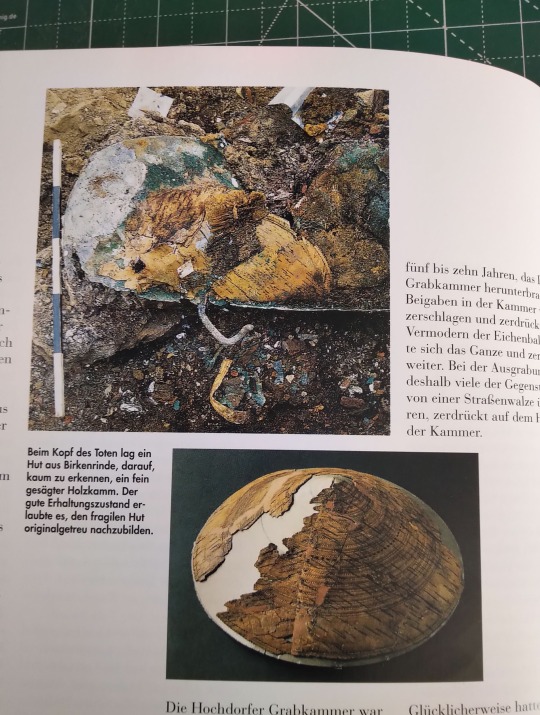
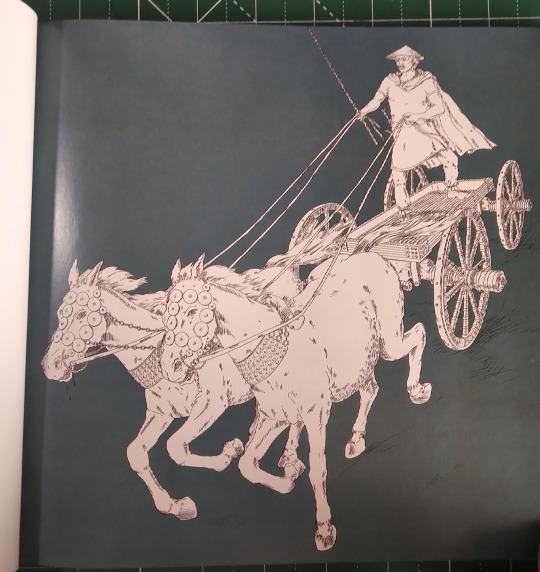


I need you guys to know that the celts of the Hallstatt culture (1200 - 450 BCE) wore conical hats made of birch bark. At least this one guy from around 550 BCE did.
These pictures are from two books about the archeological find of a celtic burial mount in Hochdorf/Enz, Southern Germany. It's near where I live. The find is amazing and very well preserved, but the most important thing is clearly that hat.
6 notes
·
View notes
Text

“The Agris Helmet (French: Casque d'Agris) is a ceremonial Celtic helmet from c. 350 BC that was found in a cave near Agris, Charente, France, in 1981. It is a masterpiece of Celtic art, and would probably have been used for display rather than worn in battle. The helmet consists of an iron cap completely covered with bands of bronze. The bronze is in turn covered with unusually pure gold leaf, with embedded coral decorations attached using silver rivets. One of the cheek guards was also found and has similar materials and designs. The helmet is mostly decorated in early Celtic patterns but there are later Celtic motifs and signs of Etruscan or Greek influence.”
9 notes
·
View notes
Text

Celtic bird-helmet (4th century BCE) - iron and bronze - found in a warrior chieftain's grave at Ciumeşti (Romania).
7 notes
·
View notes
Text
When Names are Cognate
I've had a bad habit in the past. I would say deities who's names are cognate were the same diety... oops
It's easy to do. Though scholars and pagans will say all because they have a name with similar roots, doesn't mean they are the same i.e. they were localized, could have been different based on that local, that metaphysically they are different beings, etc.
Example: I had the habit of thinking Nodens and Lugos are just other region's version of Nuada and Lugh.
I still like to look at deities who are cognate and use info to fill in gaps.
For example, Nuada. The texts have him as a king who lost his hand, but when I look at Nodens, we see a figure associated with healing and a temple of dog, dolphin, sea monster iconography and people comparing Nodens to Mars, Pan, and Neptune. So my little brain wants so much to cry "Nuada is a god of seas, fishing, healing too!" though we can't know that is the case.
My question is, aren't those gods with similar names just different regions versions of that god? I'd really like to know more.
#tuatha de danann#irish mythology#pagan#irish myth#mythology#irish lore#paganism#celtic myth#lore#gods#deities#archeology#celtic gods
6 notes
·
View notes
Text



Ancient Celtic Bronze Head of a Bull
5th Century BC
#Ancient Celtic Bronze Head of a Bull#5th Century BC#bronze#bronze sculpture#bronze statue#ancient artifacts#archeology#archeolgst#history#history news#ancient history#ancient culture#ancient civilizations#ancient gaul#celtic art#ancient art#art history
347 notes
·
View notes
Text

Inktober 2022 Day 20: Mysterious Treasure
A5, Ink and Colored on Photoshop
#inktober#inktober 2022#art#artwork#digital art#digital painting#illustration#comic art#horror#horror art#supernatural#mysterious#archeology#artefact#celtic#ancient#bronze#bronze age#gaelic#irishartist#ireland#celts#ancient celts#druids#farm#sarcophagus
4 notes
·
View notes
Text
a disclaimer~~
In regards to the thematic content of this blog, and its Old English and adjacent focus, I think this quoted statement from Dr. Ophelia Eryn Hostetter says all I want and need to:
'The recent resurgence of white nationalism and neo-Nazi ideologies worldwide have led to a new enthusiasm for medieval European history as some sort of “safe space” for racist fantasies. These readers often find my pages as they search for “Anglo-Saxon.” The term has been endowed with a disturbing racial context since its valorization in the 19th century (obviously the peoples I study almost never used used the term, preferring “Angelcynn” when discussing the Germanic peoples of England). Current research shows medieval European culture, even in its earliest times, to be far more complex and nuanced than ever before understood, and hardly a haven for any sort of ugly “white pride.” England itself was a patchwork of nationalities within the traditional seven realms of the old Heptarchy: Celtic, Scandinavian, and English, and insular monasteries were filled with people from as far away as Turkey and Africa. The powerful and wealthy nations of Africa and the Middle East sent traders, diplomats, and travelers in all directions, and many even visited the British Isles.
The idea of “whiteness” was not even really created until the European slave trade and colonialism in the 18th century. Medieval Europe was hardly perfect in its tolerance for difference, but it was far more diverse in fact than previously allowed, and much more cosmopolitan in ideas, literary influences, religious discussions, travelers, and imported goods than white nationalists would prefer. Don’t come here looking for comfort for your fantasies of genocide and oppression. My translations have nothing to give you, and I urge you to read some real, contemporary historical research on the medieval world if you want to hear actual facts.
Also — and it really should go without saying — that reading ancient and medieval texts for affirmations of contemporary abusive ideologies is pernicious and intellectually dishonest. Men’s Rights Activists especially seeking some sort of ancestry for their rape apologetics and misogyny are barking up the wrong tree, as these modern-day abuses of reason have no history, born solely as a disturbing reactionary cause against feminism, gender theory, and LGBTQIA+ rights. The Middle Ages of course thought about gender identity and sexuality and consent and many other things, they just did so in their own way, with their own enabling and limitations. The Middle Ages had its own misogynies as well as its own feminisms — and to seek just a plain reflection of whatever your ideology might be is dabbling in anachronism and faulty reading.
The Middle Ages are not here for us to colonize but to think about in their own complexity as history: lessons to be learned, and thoughts and practices to be examined. This goes for looking back at the Middle Ages to reflexively avow some sort of modern superiority or progress. Misogyny is a good example: students often assume the medieval era was just misogyny and we’re better. Misogyny pervades modern society, even if we have ways to think through it — just as it pervaded older cultures. These older cultures had their own ways of thinking through it, and people still knew it was wrong. It was not “just how they did things back then.” We have to be better readers of history and historical texts than that.'
-- https://oldenglishpoetry.camden.rutgers.edu/an-important-disclaimer/
Please keep this in mind when viewing my blog -- racists, nazis, and far-right zealots are not and will never be welcome here.
#old english#anglo saxon#history#archeology#medieval#medieval history#middle ages#early medieval#celtic history
0 notes
Text
World
open.spotify.com/playlist/4vAuwSnpdAn9CDWSgGr9xE
View On WordPress
#amor#Archeology#architecture#arquitetura#art#arttecture#brasil#Brazilian music#bruxas#cafe#celtas#Celtic#clouds#coffee#destruction#destruição#environnement#escritores#experience#flores#flowers#Freemasonry#garden#gastronomy#Halloween#Hebraico#Hebrew#indie#Israel#jazz
1 note
·
View note